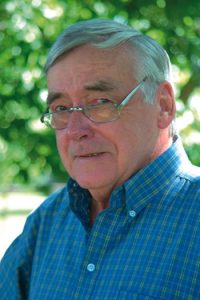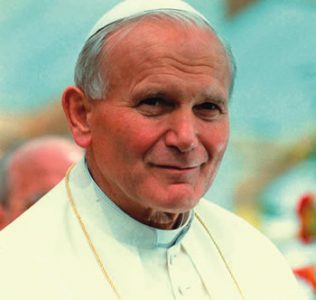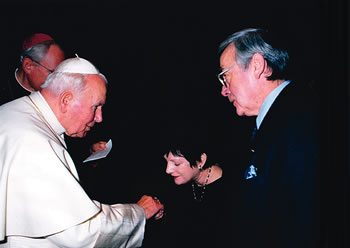The Day I Met A Living Saint
It will be a year in April since POPE JOHN PAUL II was declared a saint in an official ceremony at the Vatican. Journalist John Coleman recalls how he met the living saint in the Pope Paul V1 Audience Hall in Rome...
As Pope John Paul II, bowed as if carrying a cross, shuffled on a stick across the red-carpeted stage to cheers and claps from pilgrims across the world, the day’s Gospel, read by an aide, seemed prophetic: “The hour is coming…I am leaving the world and going to the Father.”
Indeed, he’s certainly there now, for his successor Pope Benedict XVI fast-tracked him to sainthood by announcing his beatification in May 2011 and Pope Francis led the canonisation ceremony on April 27, 2014.
I was a few metres from Pope John Paul, among a privileged group who were to be presented to him in the Vatican’s Pope Paul VI Audience Hall, packed to capacity with 8500 people. I had been granted prima fila - the front row - special seating on the hall’s stage with a guarantee of presentation.
As the Pope, surrounded by a cluster of clerical aides, made his way slowly across the stage, the burden of his pontificate - it extended more than 26 years - was all too clear. So too, was the outpouring of affection for one of the most remarkable figures of the 20th and 21st centuries.
For this was the man who played a pivotal role in dismantling Communism; whose insides were full of plastic following an assassin’s bullet and now assailed with Parkinson’s Disease; who refused to budge on issues like contraception, women priests and married clergy.
I was able to arrange the prima fila for my wife and myself with the help of Brisbane’s Archbishop Emeritus, the late Francis Rush, and former Queensland Agent General in London, Dermot McManus, once a colleague in journalism.
The negotiations were made weeks in advance and the Vatican dispatched the tickets to our Rome hotel the day before. The official photo showing us with the Pope was delivered to the hotel within hours of it being taken.
The thousands of others in the vast Audience Hall also had to apply, individually and in groups, for their seats through the then Prefect of the Pontifical Household, Archbishop James Harvey, an American.
Security in the hall, next to St Peter’s Basilica, was intense. The helmeted, red-plumed Swiss guards in their bulbous yellow and blue striped uniforms, grasping pikes, backed by Italian police, were everywhere. All those entering the hall were checked with electronic equipment.
The prima fila were told to be in place an hour before the Pope arrived. We sat beside a black-robed bishop with an elaborate head-dress. An edgy security official paced up and down, telling me brusquely to sit down when I left my seat to take a photo.
A row of pilgrims in white with a statue of Our Lady aloft sang hymns as we waited for the Pope.
Out in front on the far side of the hall was a group in wheelchairs, in the centre a cluster of soldiers from Italy’s Alpine region, long black feathers in their caps, and scattered throughout the hall, many groups of angelic looking schoolchildren. Then, in rows of seats towards the front, less than angelic looking members of Italy’s national soccer team who were to play a crucial game that night.
As the Pope sat, his hand constantly at his mouth, an aide told him the audience included people and pilgrims from Britain and Sweden, the US armed forces and their families, and nuns from India. As each group was announced, they responded in song, alleluias and cries of joy, the Italian soldiers tossing their feathered caps in the air.
The greatest outpouring of affection came for the Polish Pope from the Italians who were there in the biggest numbers from across Italy: pilgrims, police, soldiers, schoolchildren. The Parkinson’s Disease made it difficult for the Pope to smile, but with a gesture, a raised hand, he acknowledged their cries.
Speaking alternatively in English, Italian, Spanish, German and Polish, the Pope gave them all his apostolic blessing which he said he also imparted “in a special way to your children at home and dear ones who are sick.” He blessed rosaries and medals; behind me a little girl held aloft her roller skates. He spoke briefly and with obvious difficulty because of the Parkinson’s.
Aides marshalled the prima fila through the presentations. He simply extended his hand when Archbishop Harvey introduced me as an Australian journalist, but was visibly moved when my wife Marianne held out for blessing a metal cross, in her family for generations and which her mother entrusted to her youngest son when he was sent as a conscript to fight in Vietnam. The Pope took the cross reverently and, slowly and deliberately, blessed it.
Two gruelling hours had passed and they would have tested the stamina of a younger man, on his feet and extending the hand with the Fisherman’s ring. Then the Italian soldiers with the feathered caps were added to the presentation line and for Pope John Paul 11, frail and stooped, there was at least another hour to endure.
“He’s an old man and old men like to retire,” a longtime Australian religious order priest in Rome told me. “He insists on staying on because he feels he has to.
But it’s classically the end of the pontificate.”
Pope John Paul’s fast-tracking to sainthood was sealed by miracles: a French nun’s inexplicable cure from Parkinson’s Disease was approved by Pope Benedict XVI in 2010 and the second, to complete the process, sanctioned by Pope Francis, was a Costa Rican woman’s complete recovery from a deadly brain aneurism. To me, another miracle was that the Rome priest was so wrong.
For, after we met the remarkable Pope John Paul II, he continued his pontificate for another six years, dying on April 2, 2005, at 84.



 Entries(RSS)
Entries(RSS)